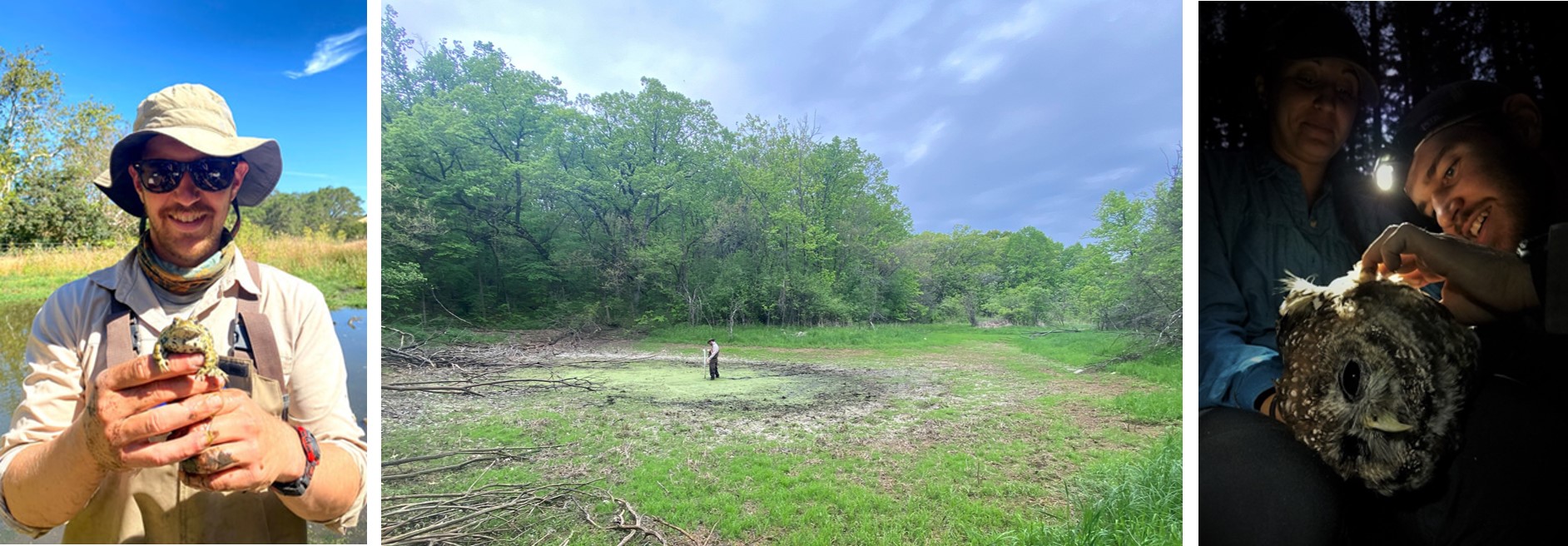Office Location
University of Wisconsin-Madison
Department of Forest and Wildlife Ecology
1630 Linden Drive
Madison, WI 53706-1598

RESEARCH
I’m an animal ecologist broadly interested in how anthropogenic disturbances affect wildlife populations and communities. I’m particularly captivated by the role that shifting species interactions play in driving outcomes like population declines and community turnover. I work on these themes in diverse systems, using diverse tools. My study systems include spotted owls in the Sierra Nevada, trematode parasites in California’s Bay Area, the amphibian chytrid fungus in Wisconsin ponds, and songbirds across the sagebrush biome. My approaches to this research are generally quantitative and empirical, leaning principally on field data and inspired by natural history observations. I also have a growing interest in causal inference and using statistical approaches borrowed from econometrics. Check out my website (https://bkhobart.weebly.com/) or Google Scholar for updates and recent publications.
EDUCATION
PhD Ecology & Evolutionary Biology, University of Colorado Boulder, 2024
MS Forest & Wildlife Ecology, University of Wisconsin Madison, 2019
BS Conservation Biology, University of Wisconsin Madison 2015
Johnson, P., T.S. Merrill, D.M. Calhoun, T. McDevitt-Galles, and B.K. Hobart* (2024). Into the danger zone: How the within-host distribution of parasites controls virulence. Ecology Letters 27(1): e14352.
McGinn*, K.A., F.A. Atuo*, G.M. Jones*, B. Hobart*, D.J. Tempel*, S.A. Whitmore*, W.J. Berigan*, R.J. Gutiérrez*, and M.Z. Peery (2022). Implications of non-ideal occupancy for the measurement of territory quality. Global Ecology and Conservation doi.org/10.1016/j.gecco.2022.e02097
Tempel*, D.H., A. Kramer*, G.M. Jones*, R.J. Gutierrez*, S.C. Sawyer, A. Koltunov, M. Slaton, R. Tanner, B. Hobart*, and M. Z Peery (2022). Population decline in California spotted owls near their southern range boundary. Journal of Wildlife Management doi:10.1002/jwmg.22168
Hobart, B.K.*, W. Moss, T. McDevitt-Galles, T.E. Stewart Merrill, P. Johnson (2022). It’s a worm-eat-worm world: Consumption of parasite free-living stages protects hosts and benefits predators. Journal of Animal Ecology 91(1): 35-45.
Wood*, C.M., N. Kryshak*, M. Gustafson, D.F. Hofstadter*, B.K. Hobart*, S.A. Whitmore*, B. Dotters, K. Roberts, J.J. Keane, S.C. Sawyer, R.J. Gutiérrez*, and M.Z. Peery (2021). Density dependence influences competition and hybridization at an invasion front. Diversity and Distributions 27:901-912. DOI: 10.1111/ddi.13240
Hobart*, B.K., H.A. Kramer*, G.M. Jones*, B.P. Dotters, S.A. Whitmore*, J.J. Keane, and M.Z. Peery(2021). Stable isotopes reveal unexpected relationships between fire history and the diet of Spotted Owls. Ibis 163(1): 253-259. doi.org/10.1111/ibi.12832
Jones*, G.M., H.A. Kramer*, S.A. Whitmore*, W.J. Berigan*, D.J. Tempel* C.M. Wood*, B.K. Hobart*, T. Erker, F.A. Atuo*, N.K. Pietrunti*, R. Kelsey, R.J. Gutiérrez*, M.Z. Peery (2020). Habitat selection by spotted owls after a megafire reflects their adaptation to historical frequent-fire regimes. Landscape Ecology 35: 1199–1213. doi.org/10.1007/s10980-020-01010-y
Hobart*, B.K., G.M. Jones*, K.N. Roberts, B.P. Dotters, S.A. Whitmore*, W.J. Berigan*, M.G. Raphael, J.J. Keane, R.J. Gutiérrez*, andM.Z. Peery (2019). Trophic interactions mediate the response of predator populations to habitat change. Biological Conservation 238: 108217.
Hobart*, B.K., K.N. Roberts, B.P. Dotters, W.J. Berigan*, S.A. Whitmore*, M.G. Raphael, J.J. Keane, R.J. Gutiérrez, and M. Z. Peery (2019). Site occupancy and reproductive dynamics of California spotted owls in a mixed-ownership landscape. Forest Ecology and Management 437: 188-200.


